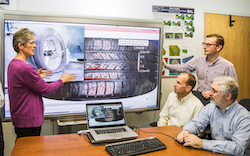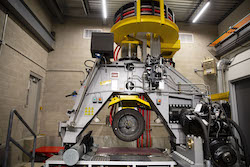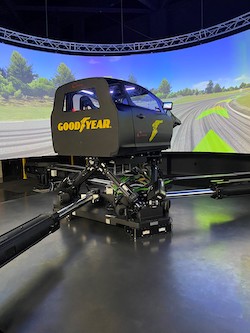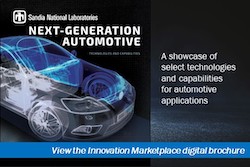ALBUQUERQUE, N.M. — Simulating how a tire’s tread, rubber and size respond to a road’s corners, angles and hills, Sandia National Laboratories and The Goodyear Tire & Rubber Co. have developed a virtual means of showing a tire’s performance before the first prototypes are ever built.

Sandia National Laboratories computer scientists Vicki Porter, left, and Byron Hanks, seated second from left, and engineers from Goodyear Tire & Rubber Co. study images of tire technology during a pre-COVID-19 work session at Sandia. (Photo by Jennifer Plante) Click on the thumbnail for a high-resolution image.
Computer simulations test a virtual tire on a virtual test machine that simulates actual road conditions. Thus, the Virtual Flat Trac reduces the need for actual tires to be tested on Goodyear’s actual Flat Trac machines in Akron, Ohio, or Colmar-Berg, Luxembourg, said Michael Skroch, Sandia’s manager of Simulation Modeling Sciences.
Forces that the physical Flat Trac measures as it puts a tire through its paces, on a conveyor belt like machine with sideways turns and acceleration, can be modeled with Sandia’s high-performance computing codes.
“Tire construction and forces on the tire can be simulated with Sandia’s codes as part of a virtual design cycle, which helps reduce engineering time and time-to-market for Goodyear,” Skroch said. “Our partnership with Goodyear in this work improves Sandia’s capability for the nuclear deterrence mission.”
The Virtual Flat Trac is one of the latest innovations in a nearly three-decade partnership between Sandia and Goodyear that is the labs’ longest-running Cooperative Research and Development Agreement, or CRADA.
Working to perfect simulations that include multiple rotations, millions of different interactions between elements, complicated tire structures and wear, temperature and pressure conditions can be extremely complex. But the challenges also advance algorithms and software that contribute to Sandia’s high-performance computing and nuclear stockpile efforts.
“Sandia also has strong interest in virtual testing for better efficiency and accelerated design for nuclear deterrence engineering and stockpile stewardship,” Skroch said. “This deepens our win-win partnership in this work going forward.”

The MTS CT Plus Flat Trac measures forces on a moving tire. Sandia National Laboratories has worked with Goodyear to develop a Virtual Flat Trac. (Photo courtesy of Smithers) Click on the thumbnail for a high-resolution image.
For Goodyear, there is also a tangible result: Virtual Flat Trac was instrumental in Goodyear tires being selected for two key vehicle models expected to begin production in 2022.
“The Virtual Flat Trac modeling using the Sandia codes was an essential part of a package we delivered to a major automotive original equipment manufacturer in order to secure new business. We have had numerous wins with the Sandia technology over the years; this is one example with a direct business impact,” said Tom Ebbott, Goodyear’s R&D Fellow for Modeling and Simulation.
Modeling in the virtual world
The Virtual Flat Trac was developed using Sandia’s Sierra suite of analysis codes, said Vicki Porter, the labs’ Goodyear technology liaison.
Put simply, designers enter the tire’s geometry, material composition, inflation and tread pattern, along with the vehicle load on the tire and predict things like the temperature of the tire, road noise and how it feels for the driver holding the steering wheel during cornering and at various speeds.
“For example, you can virtually inflate a tire, roll it through cornering maneuvers to see what kind of reactions you get to such things as the rim of the tire,” Porter said. “You can do more testing virtually, and you get a lot more knowledge of the physics behind the tire response.”

Sandia National Laboratories has worked with Goodyear to develop the tire modeling input for Goodyear’s new vehicle simulator. (Photo courtesy of Goodyear Tire & Rubber Co.) Click on the thumbnail for a high-resolution image.
The algorithms used to simulate the effects of parts rubbing and sliding, impact loads and prescribed velocities are used to inform similar tests run on components developed by Sandia for use with the nuclear stockpile. “It allows for Goodyear to get a tire on a vehicle faster; for Sandia, it gets us to production faster,” Porter said.
Goodyear recently installed a new state-of-the-art dynamic driving simulator. This will provide an avenue for the Sandia tools that are used to virtually predict tire response to be combined with a vehicle model and a road course or track model. Drivers can understand and assess vehicle handling response virtually, reducing the building or testing of prototype tires, Ebbott said.
Sandia on the long road in automotive developments
Sandia and Goodyear have worked together since 1992 and signed their first CRADA in 1993.
An early victory for the collaboration was a unique all-weather tire with a three-part tread compound, the Assurance TripleTred, launched in 2004. The Sandia codes played a principal role contributing to the design and on-time launch of this critical addition to Goodyear’s product line. The recent Virtual Flat Trac application to outfit two key 2022 vehicle models demonstrates how the collaboration continues to produce wins.
“Over the last 28 years, the main thing that we’ve been collaborating on has been computer code development,” Porter said. “Tires are one of the most effective safety features on a vehicle.”

Sandia National Laboratories technologies and capabilities have several applications to the automotive industry. For more details click the image above to read the labs’ Innovation Marketplace brochure.
Several of the labs technologies have played a role in the CRADA, including advanced computational mechanics, sophisticated geometry and meshing, computational simulation and verification, elastomeric materials, structural and tire dynamics, advanced manufacturing of rubber products, efficient characterization methods for structural dynamics, reliability tools for manufacturing processes, sensor systems, data science, human reliability and cybersecurity.
While the agreement to work with Goodyear is Sandia’s longest running CRADA, tires are just one example of the labs’ technologies and capabilities that can be used for automotive applications.
Such work includes reducing emissions through improved combustion science and fuels, more efficient ducted fuel injection, increasing battery storage safety and efficiency at the Battery Abuse Testing Laboratory, improving lithium battery performance for electric vehicles, advancing material and coating technology and developing hydrogen and fuel cell technologies critical for realizing a clean and secure energy future.
Sandia National Laboratories is a multimission laboratory operated by National Technology and Engineering Solutions of Sandia LLC, a wholly owned subsidiary of Honeywell International Inc., for the U.S. Department of Energy’s National Nuclear Security Administration. Sandia Labs has major research and development responsibilities in nuclear deterrence, global security, defense, energy technologies and economic competitiveness, with main facilities in Albuquerque, New Mexico, and Livermore, California.
Sandia news media contact: Michael J. Baker, mbaker1@sandia.gov, 505-401-3970